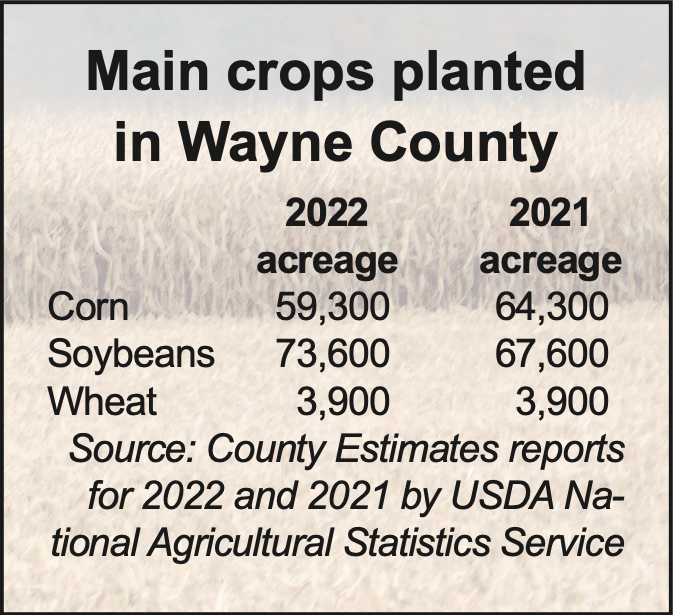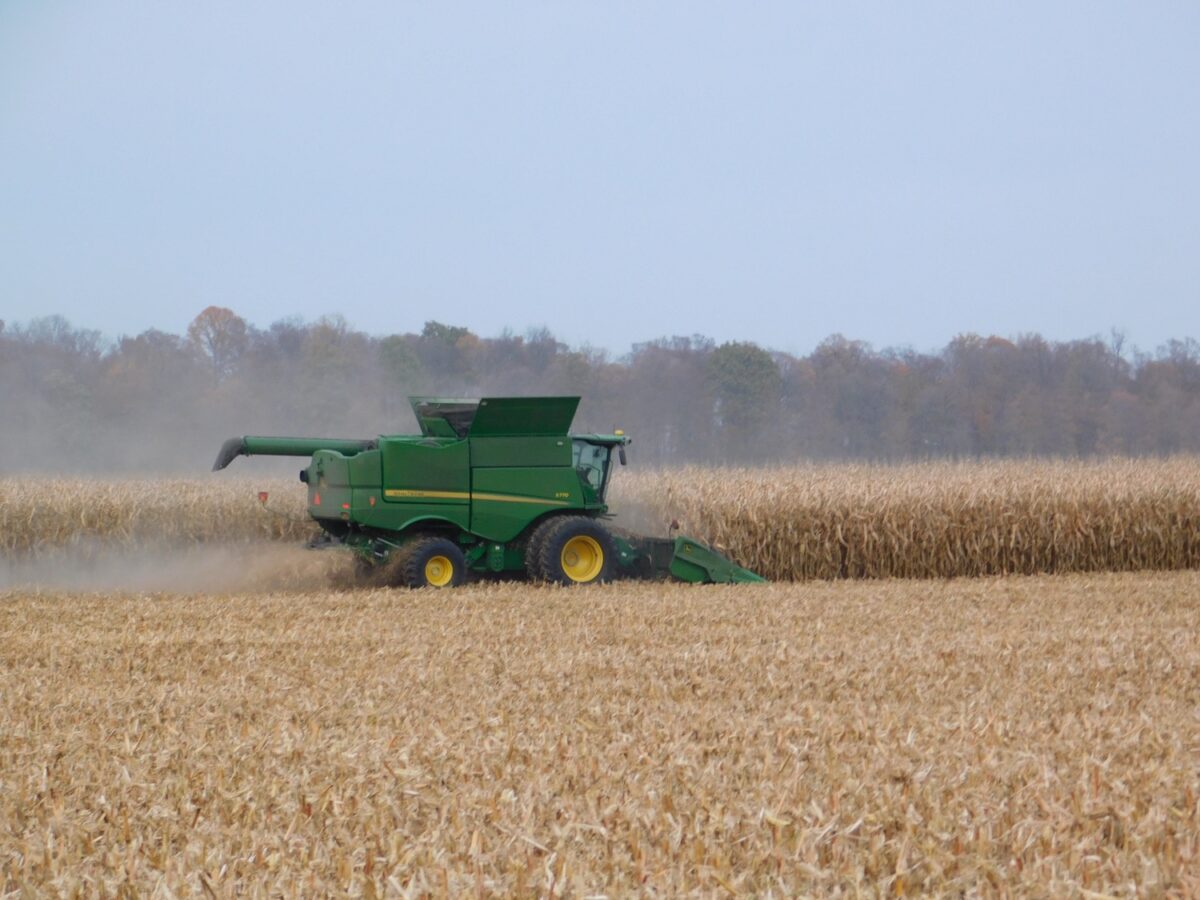Nearly perfect summer growing weather contributed to better-than-average yields for soybean and corn farmers in Wayne County. But lower prices and increasing costs have left farmers feeling less optimistic than a year ago.
“Weather conditions have been really good,” said Ben Alyea, a Williamsburg-area farmer who had finished his soybean harvest and started combining corn when he spoke to Western Wayne News on Oct. 26. “We got enough rain just in time … and we didn’t really have the heat stress.”

Jonathan Ferris, the Purdue Extension Wayne County director, agreed. He farms near Milton in his private life.
“It’s been a really good growing year. It got dry a couple of times but not when the crop was being made,” he said. “Rains were very kind to us.”
Prices rise for farmers
Atlanta Lawyer, the Wayne County Farm Bureau president, noted that farmers here are feeling an economic pinch.
“The prices of inputs continue to inch up and the markets are not reflecting that,” she said. For example, this year on her family’s farm west of Economy, “We paid double what we did five years ago for a set of rear tires on a combine.” Meanwhile, the price farmers are paid when they sell their crops are not as high.
Alyea said the prices he’s been getting for his soybeans and corn are good, but have been better. The costs of farming continue getting higher but the prices they are getting aren’t keeping up.
“Corn, we could use another dollar (per bushel). Earlier, we could have gotten $5 (per bushel) and now we’re getting $4.50,” Alyea said. “It was an expensive year. Fertilizer skyrocketed.”
He said soybean prices were “not too terrible.” Earlier this year, “Anybody could have gotten $13 (per bushel) and now (Oct. 26) we’re at about $2 less.”
Sam Faggetti is hearing the same thing from many growers. He is Wayne County sales lead for Co-Alliance, a cooperative that sells seed, fertilizers, chemicals and other farm inputs.
There has been some downward slippage in corn prices but soybean prices are fairly stable, he said.
It’s not just local farmers who are less positive. “Weakening prices for major crops and ongoing concerns about high production costs and interest rates weighed on producers’ minds …” the Ag Economy Barometer reported in late September.
The Ag Economy Barometer is a monthly survey of attitudes and outlook of 400 ag producers across the nation produced by the Purdue Center for Commercial Agriculture.
“In a nod to how variable conditions have been around the country this growing season, there were small increases in the percentages of producers who 1) expect better conditions and 2) expect worse financial conditions compared to last year,” the Ag Economy Barometer reported.
Because of the uncertainty about profitability, farmers aren’t spending as much as they might have in other years, Lawyer said. A seventh-generation farmer herself, she listens to advice from her 87-year-old grandfather, who urges a cautious, conservative approach to spending.
By Nov. 3, the family had brought in all their soybeans and about half of their corn. Like many, they’d been out Thursday until well after dark — 10:20 in her case — harvesting as much as possible in good weather.
Soybean crop comes out strong
Statewide, this year’s harvest is a little ahead of 2019, 2020 and 2022, and a bit behind 2021.
In Indiana, about 80% of soybeans planted this year have been harvested and the corn harvest is nearing the halfway point, producers report.
In his job with the Cooperative Extension Service, Ferris submits a weekly summary of local ag conditions that is used in state and national databases. Based on what he sees while driving local roads, Ferris believes Wayne County is a little ahead of those numbers.
Faggetti believes more than 90% of soybeans have been harvested here.
Soybeans have “been yielding exceptionally well,” with many fields coming in at around 72 bushels per acre, Faggetti said.
In 2022, Wayne County’s soybean crop averaged 55.9 bushels, half a bushel per acre less than in 2021, according to the U.S. Department of Agriculture’s National Agricultural Statistics Service. The state average in 2022 was 57.5 bushels per acre and 60.0 in 2021.
On their farm, Alyea said, “Early maturing soybeans did phenomenally and most of the rest is exceptional,” with yields in the 60- to 70-bushel per acre range.
Likewise, Lawyer said the early soybeans on their farm yielded higher than later plantings, largely due to drier, hotter weather in August.
Corn crop yields high with high moisture
Corn, Alyea said, is also doing exceptionally well on their farm, yielding more than 200 bushels per acre.
“Unfortunately, moisture is high in the corn,” Lawyer said. Their farm has bins where they can store the corn and use LP gas and blowers to heat it to remove some moisture. Drying is an extra cost, but without it farmers get lower prices from buyers, who would have to dry it themselves.
Faggetti noted that high-moisture corn can grow mold and develop toxins, meaning it cannot be used in animal feed or other purposes.
“A lot of the elevators are getting full and closing at noon because they have to hold the corn and dry it,” Faggetti said.
Countywide, the 2022 corn yield averaged 181.3 bushels per acre while the 2021 average hit 202.3 bushels per acre. Statewide averages were 190.0 bushels per acre in 2022 and 195.0 in 2021.
Statewide, more than 70% of both soybeans and corn harvested this year have been in good to excellent condition, according to the USDA Crop Progress and Condition Report dated Oct. 29.
Local farmers planted more winter wheat in 2022 than previously, statistics show.
Winter wheat is planted in the fall. It sprouts and stands dormant over the winter, turning green in spring and ripening in early summer. After it is harvested, most farmers put in a second crop, usually soybeans.
Wheat “prices got pretty strong and encouraged guys to put in more wheat,” said Ferris. “But prices are a little lower now so I’ll be interested in the plantings this fall.”
If good weather holds, most are expecting the corn harvest will be complete by the end of November. If not, some years have seen harvest continuing into December and even January.
A version of this article appeared in the November 8 2023 print edition of the Western Wayne News.

